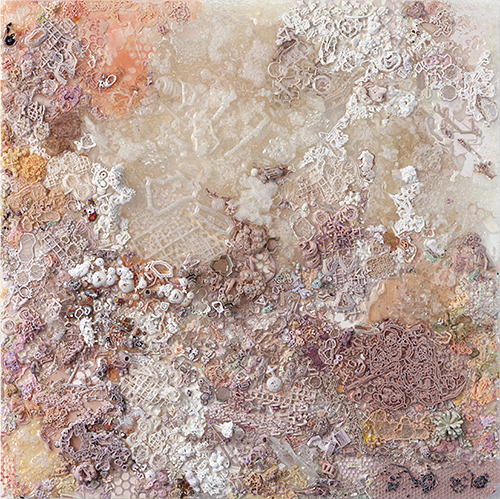Shane Hope makes invisible worlds visible. Leaders in the world of digital art have called his work “the warmest use of digital technology out there.” This week the New York artist’s uniquely fabricated sculptures, digital paintings, and holographic prints will be the feature of Ed Winkleman’s booth at the Armory Show.
If one could wield a brush on a molecular level, the outcome may resemble Hope’s stunning creations. Using molecular modeling software suites, he explodes the parameters and renders compounds both possible and not, creating densely layered, intensely colorful images that are packed with content which remains largely indecipherable. Hope takes this impenetrability to exquisite extremes in his reliefs, which like his prints are the result of impossible instructions fed into systems unused to such subversion. These constructions acquire further complexity in the form of sculptural reliefs, which Hope produces using homebuilt 3D printers, crating masses of layered, intricate chemical models in the multicolored thermoplastics used industrially for rapid prototyping.
Does Hope’s artwork cross into the realm of science fiction? Perhaps. Winklemann describes his work as “simulations of futuristic technologies that are not available yet, but scientists believe will be someday.” Through Hope's coding and computerized fabrication the viewer is allowed the kind of view into the atomic and subatomic that can usually only be found in specialized demonstrations, whether it is IBM research fellows spelling out the corporate masthead with atoms, or Ray and Charles Eames picturing cosmic timescales in their landmark Powers of Ten.

Shane Hope, "Femtofacturin' Fluidentifried-Fleshionistas", 2012 , 3D-printed PLA molecular models on acrylic substrate, 24" x 24"; Courtesy of the artist.
Hope’s work encourages questions of relativity. How, for example, in our age of near total virtualized adjacency, are we to form our own senses of scale? As we magnify our perspectives, extending our perimeters of knowledge into expanses once unseen and unimagined, the ways in which to resolve such problems of reference seem to be vanishing. Perhaps it could be that this planet has exceeded our ability to comprehend it, as it appears that amid the complex infrastructures that allow our world to function, it is very ubiquity of such intricacy that obscures these systems, allowing for an ignorance that is only questioned in stoppages or failures of life governing arrangements.
In these elaborately computer crafted prints and sculptures, the forms of compression we commonly apply to information are removed, and though these restraints are lifted, the consequences are only partially revealed, with part always remaining hidden in its own unfolding complexity. Some part of the future is here to be seen, and it is not the popular doomsday scenario of machines consuming the earth in an endlessly replicated grey goo; through this lens, what lies ahead is a time of manufactured plenty, when the greatest problem will simply be our ability to keep pace with ourselves. Both problems to be worked out, no doubt, if science will allow.
(Image on top: Shane Hope, "Sentient-Soppin' See-Source-Serum", 2012, 3D-printed PLA molecular models on acrylic substrate, 24" x 24"; Courtesy of the artist.)